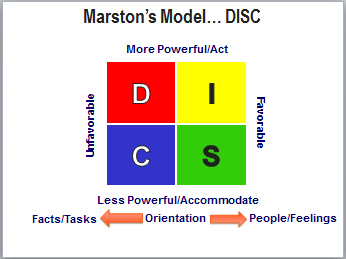With all of the debate surrounding the upcoming Batman vs. Superman movie (e.g., Ben Affleck cast as Batman; Jesse Eisenberg portraying Lex Luthor with hair; Gal Gadot cast as Wonder Woman – leading to the huge debate over whether she can carry a stand alone Wonder Woman movie), I can’t help but think about the inner circle of people who made those decisions and how the decision-making process was facilitated.

I find it ironic that the same person who created perhaps the most iconic female superhero of all times and the source of much consternation as different movie studios, directors and producers have worked to bring the character to the movie screen, is the same person whose early writings on personality traits help inform current approaches to facilitation.  American psychologist, inventor and comic book writer William Marston published Emotions of Normal People in 1928 where he explained four behavior types: Dominance (D), Inducement (I), Submission (S), and Compliance (C). He argued that these ways of behaving were based on a person viewing their environment as being favorable or unfavorable and whether they saw themselves as having control or a lack of control over their environment. Marston’s identification of these main behavioral styles provides the foundation for the DISC assessment tool that is commonly used for observing and analyzing behavior.
American psychologist, inventor and comic book writer William Marston published Emotions of Normal People in 1928 where he explained four behavior types: Dominance (D), Inducement (I), Submission (S), and Compliance (C). He argued that these ways of behaving were based on a person viewing their environment as being favorable or unfavorable and whether they saw themselves as having control or a lack of control over their environment. Marston’s identification of these main behavioral styles provides the foundation for the DISC assessment tool that is commonly used for observing and analyzing behavior.
DISC as a Superpower
Have you ever been in a work group where two team members spend a lot of the team’s time arguing because the two are “saying the same thing, but wording it differently?” When working in teams, whether it be with actual department members, the school board, or a fictitious teams like the Justice League or the Avengers,, miscommunication can quickly become a waste that makes it difficult to accomplish the team’s goals. This is one of the reasons LEAN Frog often conducts DISC leadership training when working with teams to drive efficiency or solve a problem in a department or within a school system. We have found that having participants understand the DISC model and each other team members’ DISC profile makes it easier to address the specific work opportunity at hand. Utilizing DISC training has helped LEAN Frog to accomplish the following:
- Speed up the forming, storming, norming and performing stages of team formation
- Enable facilitators to understand how to manage team member communications and behaviors so individual team members can concentrate on learning and understanding the continuous improvement concepts being addressed (e.g. Lean Six Sigma tools), rather than focusing on personalities of team members
- Allow team members to achieve consensus faster because it lessens or removes the miscommunication that occurs due to different behavioral styles and communication preferences
Use Your Superpower for Good

To quote Uncle Ben to Peter Parker (AKA Spiderman), “With great power comes great responsibility.” DISC assessments provide team members a great understanding of each other and this understanding must be used responsibly.
DISC assessments can be used for good or for ill. Even when applied with good intentions, if can be misapplied (utilized for a purpose for which the tool was not intended/designed). The DISC model does not classify people as good or bad and shouldn’t be used to do so. Understanding people’s DISC profiles can aid leaders with creating situations that are likely to motivate team members. By the same token, leaders can use the profile to create situations that elicit fear and deplete their energy.
Working in teams can be very rewarding. DISC assessments, used wisely, can help leaders and facilitators manage and motivate team members more effectively, reduce and eliminate the waste of miscommunication and improve the team’s overall efficiency. To learn more about DISC or look into DISC Leadership training for your team, feel free to contact us.